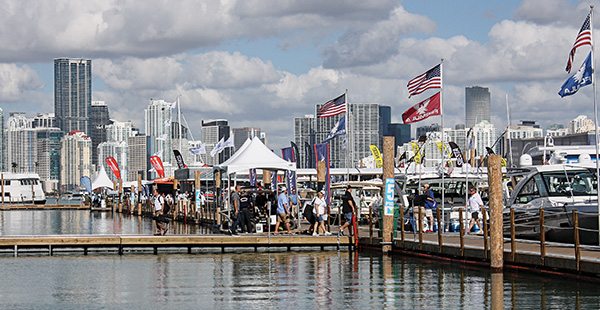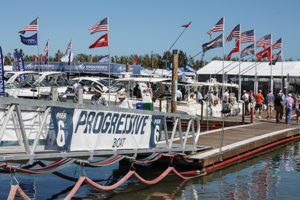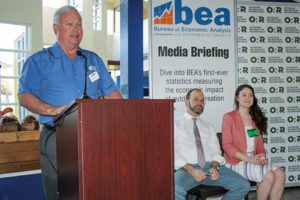Successful exhibitor sales top report from Miami

Economic impact of show, industry take center stage
The 2018 Progressive Insurance Miami International Boat Show had a successful five-day run under favorable skies, with 1,100 exhibitors and 1,400 boats on display on land and in-water.
Show attendance rose 3 percent in 2018 to 97,391, the National Marine Manufacturers Association reported.
New to 2018, Strictly Sail Miami joined power in one location at Miami Marine Stadium Park & Basin, creating a new destination for boating enthusiasts.
“It was a successful 2018 edition as exhibitors reported some of the best sales they’ve seen in years,” said Larry Berryman, manager of the Miami International Boat Show.
A new 2017 study by Thomas J. Murray & Associates, Inc., issued in conjunction with the University of Florida, showed that the Miami Boat Show produces an annual economic impact of $854.2 million, a 40 percent increase of $257.2 million since the last study was conducted in 2013.
The move of Strictly Sail Miami from Miamarina at Bayside to Miami Marine Stadium added further convenience for show attendees and exhibitors, organizers said.
In the show’s third year on Virginia Key, visitors again embraced the boat show’s park and ride model, utilizing water taxi and shuttle bus transportation to and from the show and designated offsite locations.
“Each year provides new learnings and this year, with the addition of the sailing community, we recognized opportunities to further improve our transportation plan for 2019,” Berryman said.
The Innovation Breakfast presented by GM Marine Engine Technology and the Recreational Boating & Fishing Foundation, with support from Enterprise Florida, took place within the Center Courtyard at the Miami Marine Stadium Park & Basin.
“This is one of the greatest times of the year for our industry, because so many of us are able to get together. We’ve had visitors from more than 35 countries, and virtually every state these past five days,” said NMMA President Thom Dammrich. “The Miami International Boat Show is the boating industry’s Super Bowl.”
 Recreational Boating & Fishing Foundation President & CEO Frank Peterson presented the latest consumer trends for young, multicultural and beginner boaters and anglers, and shared how the 60 in 60 effort is increasing fishing participation.
Recreational Boating & Fishing Foundation President & CEO Frank Peterson presented the latest consumer trends for young, multicultural and beginner boaters and anglers, and shared how the 60 in 60 effort is increasing fishing participation.
Women are extremely important to increasing participation in boating, Peterson said. Forty-five percent of all new fishing participants are women. Forty-two percent are girls age 6 to 12. “We have to showcase women and kids having fun,” he said. Youth are extremely important to fishing,” he added.
The Miami International Boat Show works to attract a diverse audience from all over the country, Peterson said.
Moreover, a majority of participants cited their intent to purchase a boat as their main motivation for attending the show, and 74 percent of participants either made or arranged to make a purchase at the show.
Fishing boat sales are a major driver of the industry’s sustained momentum, Peterson said, and 95 percent of powerboats, personal watercraft and sailboats in the U.S. are small, affordable boats that can be trailered to local waterways.
The NMMA announced 50 recipients of the 2017 Marine Industry Customer Satisfaction Index (CSI) Awards for excellence in customer satisfaction during the Thursday morning breakfast.
The Marine Industry CSI Awards honor boat and engine manufacturers who actively measure customer satisfaction and pursue continuous improvement to better serve their customers.
“These companies’ dedication to their customers not only builds exceptional brand loyalty, it also helps to foster lifelong boat ownership and ultimately, maintain the integrity of the boating industry in America,” said Robert Newsome, vice president of engineering standards and membership for NMMA.
The NMMA and Boating Writers International (BWI) honored winners of the 2018 Progressive Insurance Miami International Boat Show Innovation Awards, recognizing exceptionally groundbreaking new consumer marine products.
This year’s program evaluated 62 products, across 19 categories. The judges ultimately selected 17 winners and two honorable mentions in 16 categories for a total of 19 honorees.
Marine Marketers of America (MMA) announced the winners of its 10th annual 2017 Neptune Awards for Marine Marketing Excellence during the Miami International Boat Show.
“It was a robust competition, with a record number of contestants vying for additional categories,” said Wanda Kenton Smith, president of MMA. “All aspects of the marine industry were represented, from small businesses to global corporations, from in-house marketing teams to boutique and full-service agencies.”
In total, over 60 marketers from throughout the marine industry were involved in the judging process. The field drew 155 entries (up from 99 in 2016) in 21 categories covering all areas of marketing, from national magazine ads and newsletters, to video, product literature and social media.
In addition to the six new categories introduced this year, the 2017 competition also launched the “King Neptune” Best-in-Competition Award category, to recognize the best all-around entry in the overall Neptune competition.
The King Neptune award was presented to Hatteras Yachts for its “Experience M90 Panacera Launch” advertising campaign, created by Hatteras Yachts and Adventure Advertising.
“The results of this year’s contest prove that innovation and creativity are alive and well in the boating marketplace,” said Sally Helme, MMA vice president and Neptune Awards chairperson. “The Neptune Awards are judged on the basis of marketing excellence with a variety of criteria and benchmarks for each category. This year, many categories were hotly contested, evidenced by a tie in the popular category of mobile apps.”
The complete lists of all CSI, Innovation and Neptune award winners are available at BoatingIndustry.com.
The 2019 Miami International Boat Show will be held Feb. 14-18 at Miami Marine Stadium Park & Basin.
New report calculates outdoor recreation economic impact
The U.S. Bureau of Economic Analysis made a special appearance at the Miami International Boat Show to present never-released data that measures economic significance of outdoor recreation, including boating and fishing.
The new research is part of the new BEA Outdoor Recreation Satellite Account established in 2016 by federal law, covering years 2012-2016 – the first step in aiding decision making by policymakers and managers of public lands and waters.
Satellite accounts complement BEA’s core statistics by pulling together additional detail on specific industries, such as travel and tourism or outdoor recreation.

Lucas Hitt, U.S. Bureau of Economic Analysis
communications division chief, and Tina Highfill,
economist, prior to the start of a special
industry briefing at the Miami International
Boat Show.
The prototype statistics show the outdoor recreation economy through two different lenses: by type of activity, such as hunting or sailing, and by industries that produce goods and services for outdoor recreation, such as manufacturing or retail trade.
BEA’s initial findings report that outdoor recreation accounted for 2 percent of the U.S. economy, or $373.7 billion, in 2016.
More importantly, the outdoor recreation industry’s GDP has increased an average of 4.4 percent since 2012, significantly greater than the 3.6 percent average increase in the overall U.S. GDP.
Outdoor activities centered on motorized vehicles, including RVs and motorcycles, stand out from the pack, accounting for $59.4 billion of gross output in 2016, more than half of it attributed to RVs.
Boating and fishing together represented $38.2 billion in gross output; hunting, shooting and trapping accounted for $15.4 billion.
In 2016, conventional activities accounted for 36.7 percent of outdoor recreation gross output and other activities were 22.1 percent. Supporting activities, such as trips and travel, accounted for the remaining 41.2 percent.
When focused on industries, BEA estimated outdoor recreation’s role in each industry’s “value added” – a measure of its contribution to the U.S. economy, or gross domestic product.
“We think this a significant milestone and accomplishment for outdoor recreation,” said Thom Dammrich, Outdoor Recreation Roundtable chair. “This is the first time the federal government has measured outdoor recreation and its component parts as an entity.”
ORR was formed in February 2018 with the merger of the Outdoor Recreation Industry Roundtable, a coalition of America’s leading outdoor recreation trade associations, and the American Recreation Coalition, an organization of recreation interests that has had a significant and positive impact on outdoor recreation for more than three decades.
ORR is committed to advancing the basic elements needed to grow this vital economic sector, including sound and sustainable management of U.S. public lands and waters, and updating infrastructure and technology on those lands to create quality experiences in response to changing recreation preferences.
“The source data that we used for this was very broad,” said Lucas Hitt, BEA communications division chief. “We pulled government data from the Census Bureau, U.S. Labor Statistics, and used private sector data, data from NMMA, and the U.S. Fish and Wildlife Service.”
Outdoor recreation grew at 3.8 percent in 2016, compared to 2.8 percent for the economy as a whole, Hitt said.
“When we are talking about the boating and fishing categories in relation to these statistics, we are talking about activities that are specific to participating in those activities,” Hitt added.
Dammrich said the BEA has been highly responsive to the outdoor industry and has been providing first-time, objective data about the value of outdoor recreation.
“In our opinion, the numbers that came out were impressive, and in our industry’s favor. We can now work with the current administration and Congress and move forward. This will help us grow the Outdoor Recreation Account,” Dammrich said
Dammrich said a key priority for Outdoor Recreation Roundtable members is finding permanent funding for the new account. “Doing that will make this information a lot more useful at the state level,” he added.




